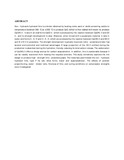| dc.description.abstract | Non - hydraulic hydrated lime is a binder obtained by heating rocks, sand or shells containing calcite to temperature between 900 °C an d 950 °C to produce CaO, which is then slaked with water to produce Ca(OH) 2 . It sets in air and forms CaCO 3 , which is produced by the reaction between Ca(OH) 2 and CO 2 , and its strength development is slow. However, when mixed with a pozzolanic material, it sets in water and forms C - S - H and C - A - H, which are produced by the reaction between Ca(OH) 2 and SiO 2 and Al 2 O 3 in pozzolana. The strength development is greatly improved. Lime - pozzolana binder has several environmental and technical advantages. A large proportion of the CO 2 emitted during the production is absorbed during the hydration, thereby reducing its total carbon release. The carbonation of Ca(OH) 2 offers a cheap avenue for carbon sequestration. In addition, lime is sustainable because it can be readily recovered from heating the recycled concrete. This study tentatively explores the mix design to produce high - strength lime - pozzolana paste. The materials used include the non - hydraulic hydrated lime, type F fly ash, silica fume, water and superplasticizer. The effects of powder proportioning, water - binder ratio, fineness of lime, and curing conditions on compressive strengths were investigated | en_US |

